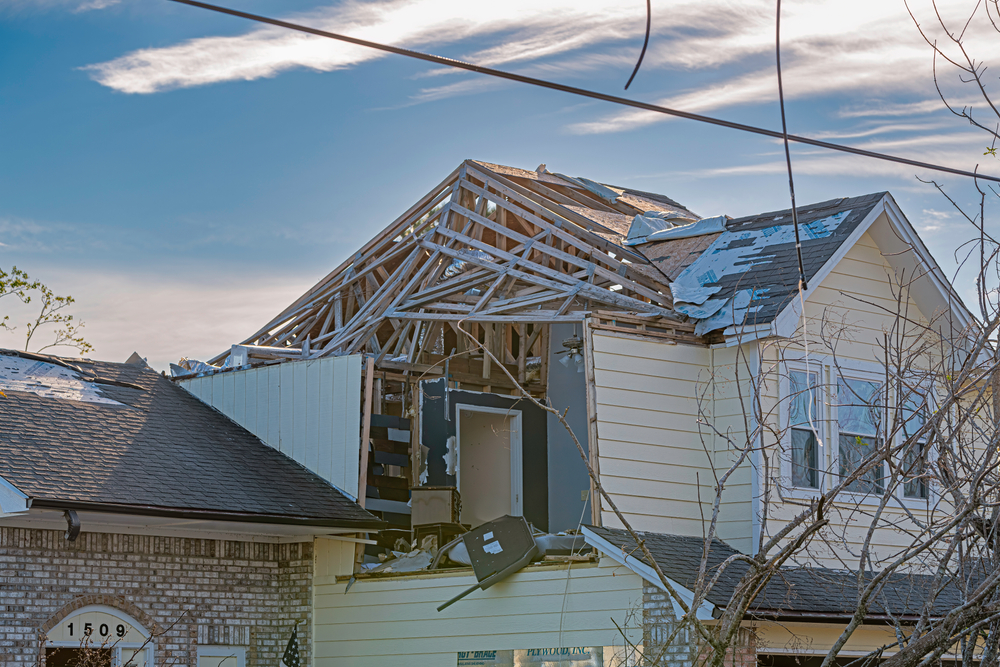Wind & Hail Home Insurance Coverage Guide

Hailstorms can do a tremendous amount of damage to your house and roof in very short amount of time and if you are not properly insured you could end up having to cover the cost of repairing your home out of pocket.
We thought it might be helpful to do a quick overview about hail damage and homeowners insurance, keep reading to learn everything you need to know about how to protect your home against hail damage.
What is hail?
A hailstorm will form when an updraft from a thunderstorm carries raindrops up into the extremely cold areas of the atmosphere. The raindrops then freeze and fall to the ground when they become too large for the updraft to support.
While hail can be small, when a severe thunderstorm hits the damage can be extensive as the hail can range 1 to 1.75 inches in diameter. Hail this size can damage your home and roof. Much bigger hail is possible with major storms generating hail the size of a grapefruit (4.5 inches in diameter), which can do major damage to your home and car.
While the Midwest and west are home to some of the largest hailstorms on record, it is possible for hail to fall anywhere in the United States. In most cases, February and July are the most active months for hailstorms.
According to Verisk, over 6.2 million properties in the United States were impacted by hailstorms in 2020. Roughly a quarter of those properties were in Texas which saw the most hailstorms in 2020. Here is a quick list of the top 10 states for hailstorms in 2020:
- Texas – 601 hailstorms
- South Dakota – 377 hailstorms
- Kansas – 341 hailstorms
- Oklahoma – 341 hailstorms
- Nebraska – 313 hailstorms
- Minnesota – 268 hailstorms
- North Dakota – 226 hailstorms
- Missouri – 200 hailstorms
- Colorado – 168 hailstorms
Hailstorms and Homeowners Insurance
A standard homeowner insurance policy may cover wind and hail damage depending on which insurance company and state you live in. This includes damage to your siding and windows as well as your roof. In addition, if your policy covers other structures (most policies do) any unattached structures on your property (barns, outbuildings, sheds) are also protected against hail damage, up to your coverage limits.
While the majority of homeowner policies are replacement cost coverage these days, there are insurers that still sell actual cash value policies which take deprecation into account when valuing your home and possessions after a claim. This means that if your roof is 20 years old, your insurer will take that into account when putting a value on it for your claim. With an actual cash value policy, you will be on the hook for a major portion of the cost of your new roof.
A replacement value policy will replace your roof with a brand new one of similar quality. While replacement value polices tend to be a bit more expensive, they are usually well worth the cost when it comes time to make a claim.
It should be noted that some insurers only offer actual cash value for your roof if it is above a certain age when your purchase your policy. Check with your insurer, read your policy in full and ask questions about anything you don’t understand.
A homeowners policy will also cover hail damage to your possessions in the event that hail get into your home via a hole in the roof or damaged windows and walls.
Many Insurers Have Windstorm Deductibles
Another issue to be aware of when it comes to hail damage is windstorm deductibles. Many insurers have instituted windstorm deductibles on their homeowners policies in states that allow it. In most cases, a hailstorm and the resulting damage would activate the windstorm deductible, but it can vary by insurer and state.
Windstorm deductibles are often percentage deductibles which means that your deductible for windstorm damage is a percentage of your total dwelling coverage. As an example, if your home is insured for $300,000 and you have a 5 percent windstorm deductible, you will have to fork up $15,000 as your deductible.
IMPORTANT: Some states require a separate policy
In some states where wind and hail damage is common, a typical homeowners policy may exclude this type of damage, meaning you will have to purchase a separate wind and hail insurance policy to cover these perils. As an example, homeowners in coastal communities in Texas usually need to purchase a separate policy. Check with your insurer to make sure wind and hail damage is covered.
Do I need windstorm insurance?
Windstorm insurance is not legally required but if you live in a high-risk area and your homeowners insurance does not offer coverage for wind and hail damage, your mortgage lender will most likely require that you carry this coverage.
According to the Insurance Information Institute, the following states allow insurers to exclude windstorm damage or allow separate windstorm deductibles:
- Alabama
- Connecticut
- Delaware
- Florida
- Georgia
- Hawaii
- Louisiana
- Maine
- Maryland
- Massachusetts
- Mississippi
- New Jersey
- New York
- North Carolina
- Pennsylvania
- Rhode Island
- South Carolina
- Texas
- Virginia
- Washington D.C.
If you live in one of these states, you should read your policy and check the details of wind and hail coverage. It is important that you have great home insurance coverage, but also protect your home and finances by purchasing a wind and hail insurance policy. Please request a quote online or give us a call today to review all home insurance coverage options.
